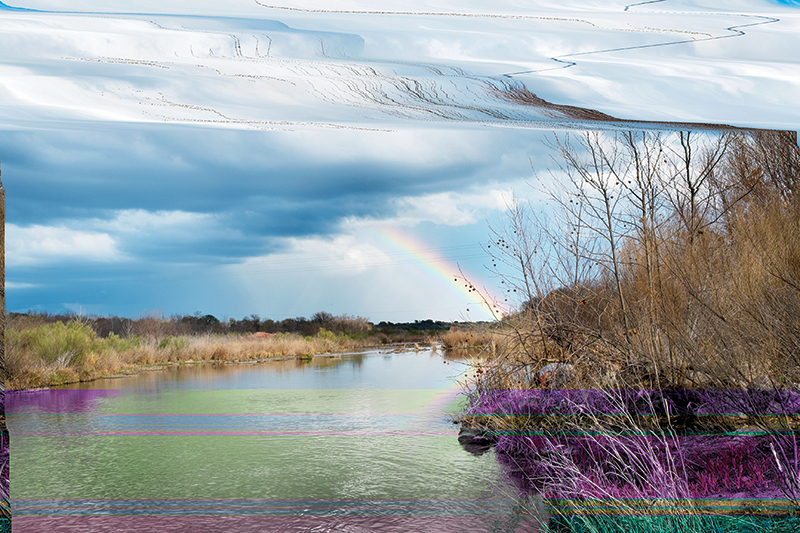Goodnight 2017: UMOCA’s 2018 Galleries
Art
January is an ebb and flow of change. It’s the month of embracing fresh starts, of constantly writing “2017” when we mean “2018.” In that spirit, the Utah Museum of Contemporary Art (UMOCA) put on a fabulous all-museum exhibition opening for five new shows from dozens of artists, including a collection curated by Earl Gravy. Artist in residence Justin Watson also unveiled a curated project of 30 artists, and UMOCA’s smaller galleries are now home to some excellent works by Eric Overton and Merrit Johnson, all exploring physical and political landscapes through nontraditional inquiry.
As you enter, you’ll first see Overton’s Monument (runs through March 17), which shows odd photographs of Southern Utah landscape. These monuments and rock formations should be familiar to most Utahns, but their presentation makes them feel a bit foreign.
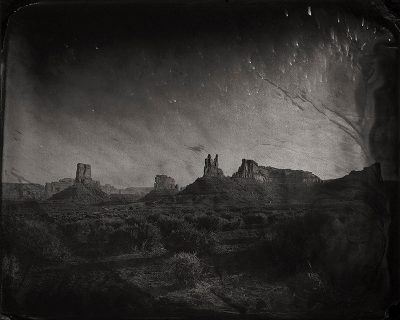
Overton transforms the familiar to strange through his process: He uses a mid-19th century process known as wet-plate collodion. The relatively laborious process (compared to modern digital cameras) produces grainy black-and-white images, which contrasts how these landmarks are usually depicted, often as shining, saturated monoliths, fulcrums around which Utah gains identity. “[The process] is prone to what I would call fortunate mistakes,” Overton says. It’s led to him spending more time with the land than he would have otherwise. The effects of his time and process beget a sense of mystery many of us may have lost about these structures. The show is evocative of that first time you saw these lands in person, when you first felt their alien nature. To feel that again after decades of familiarity captures a wildness your average landscape photography won’t.
The Street Gallery houses Home Bodies, Away Teams (runs through May 13). The space is curated by Earl Gravy, name of the collaborative duo between L.A.-centric artists Emma Kemp and Daniel Wroe. Gravy has brought together 12 artists working in sculpture, installation, performance and more to explore the concept of “suspension,” which they describe as the parts of a system that absorb “shock” and allow for the suspension of disbelief outside the setting of mere stories. Wroe is from Tennessee and Kemp from England, and while they met in California, their shared interest in deserts and landscapes brought them to study fringe desert communities, eventually leading them to a spiritualist commune here in Utah. “We had been doing so much of this research in Utah,” says Kemp. “I just felt like we know the L.A. audience really well and that it would be nice to bring this piece, inspired by Utah, here.”
You can see some of this desert landscape in “Home of Truth,” a video of abandoned and open spaces. You’ll see different viewpoints through a picture-in-picture violator, focusing on mundane or odd things—mounds of land and old photographs and letters, even grave sites. These are from the commune like those Earl Gravy has researched. Home Bodies, Away Teams is the kind of installation you bounce around, latching onto pieces that call to you. “Till We Have Faces” is particularly entrancing: Classical busts are broken and laden with blue velvet on a stage with two screens, one in front of the other. One shows text, the other imagery, such as pine needles flickering with blue and green light, then vases of flowers being knocked over in reverse. Though it’s hard to keep up with both, the imagery has a ritualistic feeling divorced from how we tend to visualize “rituals.” My experience with Home Bodies carried the theme from Monuments, which is to say I relearned to perceive things that had ready categories in my mind. João Maria Gusmão and Pedro Paiva both showed various movies, running on 16mm film projectors, of peacocks and cowfish, each recording slowed down almost imperceptibly. First looking at it as though it were nothing, I slowly realized that I was watching the cowfish die.
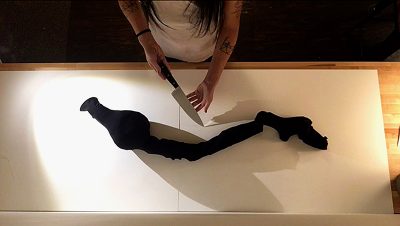
Tucked away in the back of the museum are some of the best works. Merrit Johnson’s Exorcising America (runs through May 19) is a short film in two parts. One part features the artist in a kind of in-flight safety video style addressing the viewer about how to properly take a fall. “Look around for comfortable landing spots,” Johnson says. “Carpet, grass, other bodies.” The imagery grounds itself literally, but always offers up metaphorical interpretations for taking a fall. As an added benefit of taking fall, the film says, use the opportunity to learn how to get back up, too. You may face physical horror or ideological horror, but our response should be similar: Get back up.
The second half of Exorcising America is a DIY video on how to handle monsters, which are vaguely defined but represented by a long, dark-black snake-like sock. Johnson narrates and tells the viewer to acquire something sharp, or to “get ready to use your teeth.” She cuts the snake in half, gutting its innards. It’s a strange vector for critiquing life’s adult monsters, the terrible power structures under which most of us live, but its presentation as a DIY craft lends a sense that, yes, we really can protect ourselves. “Inhale with purpose,” Johnson narrates. “We can refuse. We can teach our monsters not to be monsters. Or we can kill them.” She turns the skin of sock snake inside out, tying her hair back like a warrior.
The Hijab Project, put together by the organization Al Ahad, is not one of the newer exhibits, but perhaps one of the most important. It displays creatively handmade hijabs placed on customized mannequin heads, both together with a quote from the young woman who created it. The project actively challenges the anti-feminist notion that hijabs, and those who choose to wear them, are evidence that Muslim women reinforce their own gender oppression. Instead the project gives voice to girls’ lived experience of wearing such culturally significant clothing. “I am not oppressed, abject, overdressed—give it a rest!” says Anisa, 17. “This is the real reason why I dress: my truthfulness and my integrity … The hijab encapsulates my identity.” The energy of the exhibition demands your respect, and it deserves it.
Last upstairs is digital video of a play performed by the YouTheatre Drama Company II, Class of Spring 2017. DREAM is a retelling of Susan V. Bosak’s Dream: A Tale of Wonder, Wisdom and Wishes, and its young performers ask tough questions about dreams and possibility. “How many dreams will we have in our lifetime?” One child asks. Though only about 10 minutes, seeing the young students lead, embrace the unknowable and create performance and production out of their own desire is inspiring, a model for what young learning could look like.
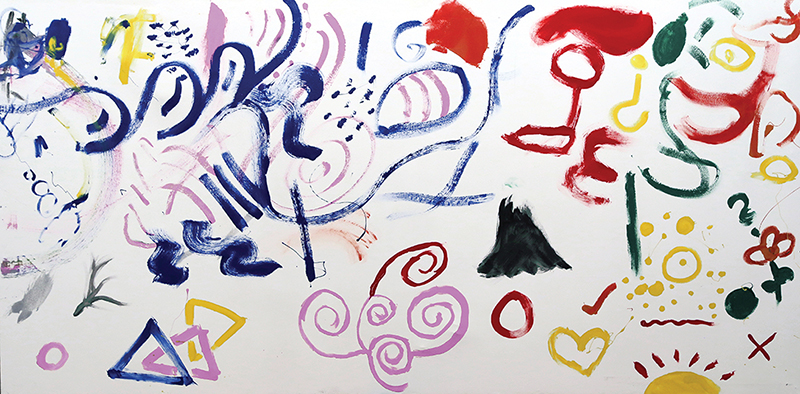
Out of every exhibition, Desire Lines is the most expansive, occupying the Main Gallery through May 26. Desire lines is a term used to describe the paths through nature that are made out of the raw desire to explore, humans stepping outside their own boundaries of established routes to form something new—whether it’s the path of least resistance or forging something more demanding. Desire Lines as an exhibition is about coming to landscape in new ways, beyond the tried and true plein air. The artists here are walking new paths in our landscapes and acknowledging human presence rather than glorifying a pristine ideal. For example, Carly Glovinski’s works Nature Library: The Earth and Index Library: The Earth are recreations of books and indexes regarding regions of Western landscape—information about a place rather than photorealistic recreations of it. It begs the question: “Does all the meta information about a landscape constitute an understanding of it?” Can information itself be a landscape? It certainly necessitates interpretation.
Penelope Umbrico’s piece Range: of Masters of Photography runs with this idea as well. Umbrico takes well-known photos of mountains from masterclass series of photographs, such as Apertures Masters of Photography, and runs them through several photo-editing phone apps, stripping the polish and shamelessly welcoming the degradation introduced by the process like remora on a whale. The results are images of mountains that manage to be unpredictable, colorful and different all without the sensation that the mountain is an anchor. The tool of guidance dislodged, what is the landscape now? What are we if we discard our traditional points of reference?
Kelly Larsen’s Newtown Creek, 1/10/12–01/10/13 is a piece of cotton canvas that has sponged filthy water in Newton Creek, New York, for three months. Although some its filth is due to Hurricane Sandy, Larsen argues that the violence of the industrial age must move into a healing period. Larsen collects items like this damaged canvas, which is truly disgusting to look at, and shares them in their affected state—shredded paper, charred architecture beams, even just plastic containers. The canvas is not the kind of art you want to touch (it really is gross looking), and that thought alone communicates a darker side of desire lines.
One of the more curious pieces is Between Here and There by Amelia Carley. Carley breaks down the fundamental ingredients of how we visualize landscape art and gives us the literal pieces. A painted sunset on canvas is hit by a streak of light that falls off the frame and drapes onto a mound of sand foam sitting in the corner like a lump of earthy dirt. The component parts are connected but not composed, and it’s curious to see these elements detangled and literalized. The sheer physicality is something worth seeing.
Though there are many more pieces in this gallery, two others stuck out. Umbrico has created probably the most alluring piece of the gallery right now in 35,073,658 Suns from Sunsets from Flickr (Partial) 1/08/18. A big title and an even bigger piece, Umbrico searches Flickr for images tagged “sunset,” then crops them into 4” by 6” machine prints, always keeping the sun centered. The piece is named for how many results are returned by the site’s search engine the day of the installation. In this case, 35 million results on January 8. This installation is selfie central—the sun’s infinite allure collaged into a wallpaper of sorts that begs a picture. It reinforces not just the ubiquity of sunsets, but the ubiquity of our compulsion to capture them, to upload stars into the boundless internet ether. It’s a beautiful piece that reminds us of the things we can’t help but find fucking pretty.
The last piece in this exhibit that drew me in was Michael Handley’s Made in Utah (The Trembling Giant). By using a hacked document scanner to print on vinyl, Handley has created a large tapestry-esque printing of logs and branches, parts of Pando, The Trembling Giant. Pando is a clonal colony of a single aspen tree with a massive underground root system. It’s located a mile southwest of Fish Lake on Route 25. Pando is currently thought to be dying, and the effect of the streaks made from the printer gives the wood a saggy look, cut perpendicularly by lines of imperfect printing. Like Umbrico’s Range, it capitalizes on the purposeful failing of technological hardware to create an image that looks like it’s dying—man-made age rings on a living organism. Creepy is too strong a word, but when you see it, you’ll know how you feel.
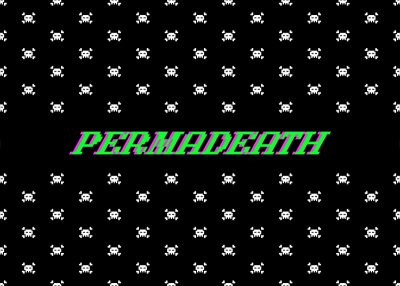
Lastly, I visited UMOCA’s A.I.R. Space Gallery to see Justin Watson’s PERMADEATH. “I gave [29 artists] the most basic instructions of, ‘build a society,’” Watson says. In return he asked for something back. “I wasn’t like, ‘You need to make an artifact, a literal representation of your society.’ It was pretty open-ended.” What he got back is an enormous amount of material that reflects the creativity of each artist, indeed artifact-esque but one step removed, artifacts that are a consequence of world building. As a viewer, there are countless to choose from and latch onto. In a corner is Cara Krebs’ The Dream Home of Cara As a Child, which depicts a fantastical yet tasteful modernist home through diorama, something of a bonsai tree but more curated with horses, lights and a waterfall. Christopher Kelly has a particularly strong showing with MUST HAVE BEEN ONE HELL OF A STRONG ROPE, which is like set design on steroids: A small room almost completely adorned in floral prints, vases, trinkets, rugs, ornate TV trays and flowers is infiltrated by a dormant figure sitting in the corner, armored in futuristic, polygonal metal, reminiscent of a knight. It’s simultaneously comforting and alien, like a grandmother’s pristine yet antiquated house. Tabitha Nikolai contributed Shrine Maidens of the Unseelie Court, a 3D virtual game environment à la Gone Home, but much more queer, dreamy and obsessive, at first putting the player outside a house surrounded by large spiders. From outside the house you can see through the walls, so that everything inside is visible, but once inside, the walls firm up, and you must use traditional doors. Eventually you find a staircase leading into another realm. You emerge from water and see a lone room with a computer in it, at which point you engage in AOL-style instant messaging with someone who seems to know you, as though you’d been there all along.
PERMADEATH is dense as hell. Tanja London even produced an audio tour that interacts with PERMADEATH pieces as well as UMOCA as whole, designed to take the listener on an hour-plus journey through the museum. It aligns with Watson’s interest in exploring his role as artist-in-residence at UMOCA. “I’m interested in institutions,” he says. “I’m interested in the power dynamics between me and the museum.” London’s tour does this in effect. “She took my model and then created her own sub-model within that to examine the institution,” he says.
Watson feels the premise of PERMADEATH comes off as juvenile. “It just seems like an easy question to ask people. Honestly, the real impetus for PERMADEATH is that all of us now, socially and politically, think we know what to do with everything around us.” It’s not all positive, not all negative, he notes, and in fact people have expected the exhibition to take a more dystopic tone given our current political climate. But there’s a bubbling sense that we can create structures that are better for us than the ones we’ve been handed. “We’re inventing everything around us. I see self-curation,” Watson says. Indeed, we got this.
After spending several hours in the museum on its opening night, I came away feeling firmly footed in 2018, showered in enough artistic energy to wash off the 2017 stink. Artists here are coming at old concepts from new vectors, no longer chafing from the annals of last year but harnessing it. Let me say, without remorse, that moments of healing have never been so precious. Visit utahmoca.org for information on times and dates for all exhibitions.
